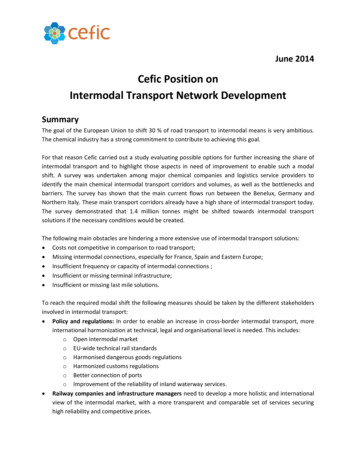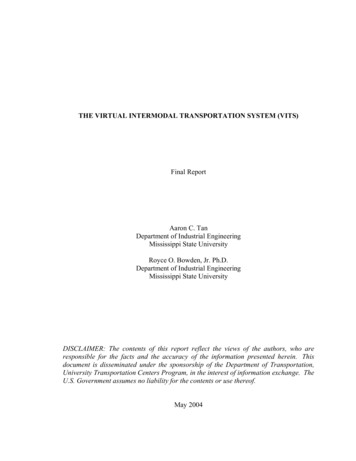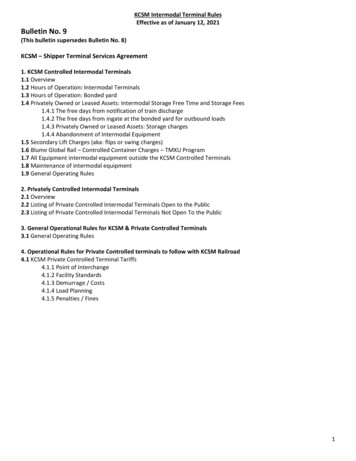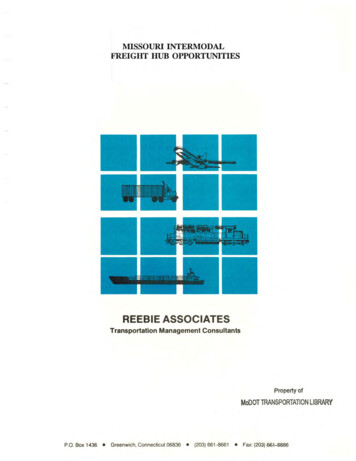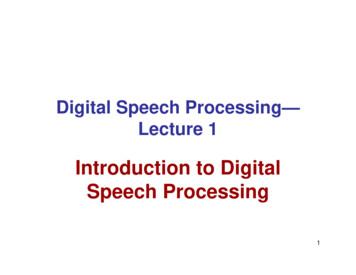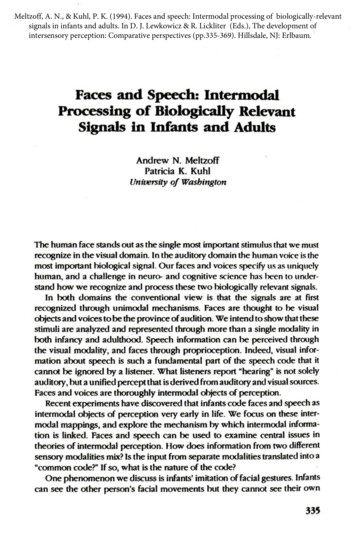
Transcription
Meltzoff, A. N., & Kuhl, P. K. (1994). Faces and speech: Intermodal processing of biologically-relevantsignals in infants and adults. In D. J. Lewkowicz & R. Lickliter (Eds.), The development ofintersensory perception: Comparative perspectives (pp.335-369). Hillsdale, NJ: Erlbaum.Faces and Speech: IntermodalProcessing of Biologically RelevantSignals in Infants and AdultsAndrew N. MeltzoffPatricia K. KuhlUniversity of WashingtonThe human face stands out as the single most important stimulus that we mustrecognize in the visual domain. In the auditory domain the human voice is themost important hiological signal. Our faces and voices specify us as uniquelyhuman, and a challenge in neuro- and cognitive science has been to understand how we recognize and process these two hiologically relevant signals.In hoth domains the conventional view is that the signals are at firstrecognized through unimodal mechanisms. Faces are thought to he visualobjects and voices to be the province of audition. We intend to show that thesestimuli are aru lyzed and represented through more than a single modality inhoth infancy and adulthOod. Speech information can he perceived throughthe visual modality, and faces through proprioception. Indeed, visual information ahout speech is such a fundamental part of the speech code that itcannot he ignored hy a listener. What listeners report "hearing" is not solelyauditory, hut a unified percept that is derived from auditory and visual sources.Faces and voices are thoroughly intermodal ohjects of perception.Recent experiments have discovered that infants code faces and speech asintermodal ohjects of perception very early in life. We focus on these intermodal mappings, and explore the mechanism hy which intermodal information is linked. Faces and speech can he used to examine central issues intheories of intermodal perception. How does information from two differentsensory modalities mix? Is the input from separate modalities translated into a"common code?" If so, what is the nature of the code?One phenomenon we discuss is infants' imitation of facial gestures. Infantscan see the other person's facial movements hut they cannot see their own335
MELTZOFF AND KUHLmovements. If they are young t!nough, they have never seen their own facein a mirror. How do infants link up the gestures they can see hut not feelwith those that they can feel hut not see? We show how this phenomenonilluminates models of intermodal development. New data indicate that infantscorrect their behavior so as to converge on the visual target through a seriesof approximations. Correction suggests that infants are guiding their unseenmotor behavior to bring it into register with the seen target. In this sense,early imitation provides a ke-y example of intermodal guidance in theexecution of skilled action. Other new data reveal an ability to imitate frommemory and imitation of novel gestures. Memory-based facial imitation isinformative because infants are using information picked up from onemodality (vision) to control nonvisual actions at a later point in time, afterthe visual target has been withdrawn. This suggests that infant intermodalfunctioning can be mediated by 5tored supramodal representations of absenteveniS, a concept that is developed in some detail.Intermodal speech perception involves auditory-visual mappings between the sound of speech and its visual instantiation on the lips of thetalker. During typical conversations we see the talker's face, and watch thefacial movements that are concomitant by-products of the speech event. Asa stimulus in the real world, speech is both auditory and visual. But is speechtruly an intermodal event for the listener/observer? To what extent are thevisual events that accompany the auditory signal taken into account indetermining the identity of the unit?Adults benefit from watching a talker's mouth movements, especially innoise. People commonly look at the mouth of a talker during a noisy cocktailparty because it feels like vision helps us to "hear" the talker. The secondauthor of this chapter has been known to say to the first: "Hold on, let meget my glasses so I can hear you bener." These are not examples ofsuperstitious behavior. Research shows that watching the oral movementsof a talker is equivalent to about a 20-dB boost in the auditory signal (Sumby& Pollack, 1954). A gain of 20-dB is substantial. It is equivalent to thedifference in level between normal conversational speech (65 dB SPL) andshouting (85 dB SPL).Here we also discuss new research on auditory-visual "illusions" showingthat visual information about speech virtually cannot he ignored by thelistener/observer. The development of the multimodal speech code and thenecessary and sufficient stimulus that allows adults and infants to detectintermodal speech matches are explored. Finally, we hypothesize that infantbabbling contributes to the intermodal organization of speech by consolidating auditory-articulatory links, yielding a kind of intermodal map forspeech. Understanding the multimodal nan1re of the speech code is a newand complex issue. The mapping between physical cues and phoneticperceprs goes beyond the realm of the single modality, audition, typically
14. FACES AND SPEECH337associated with it. This chapter reveals the rather surprising extent to whichspeech, both its perception and its production, is a thoroughly intermodalevent both for young infants and for adults.INFANT FACIAL IMITATION AS AN INSTANCEOF INTERMODAL FUNCJ10NINGThere is broad consensus among developmentalists that young infants arehighly imitative. However, all imitation is not created equal: Some is morerelevant to intermodal theory than others. For example, infants can see thehand movements of others, and can also see their own hands. In principle,infants could imitate by visually matching their own hands to those of another.This would require visually guided responses and visual categorization (theinfant's hand is smaller and seen from a different orientation than the adult's),but it would not put much demand on the intermodal system per se.What is intriguing for students of intermodal functioning is that facialimitation cannot, even in principle, rely on such intramodal matching. Infantscan see the facial movements of others, hut not their own faces. They can feeltheir own movements, but not the movements of others. How can the infantrelate the seen but unfelt other to the felt hut unseen self? What bridges thegap between the visible and the invisible? The answer proposed by Meltzoffand Moore 0977, 1983, 1992, 1993; Meltzoff, 1993) is intermodal perception.It has been known for 50 years that 1-year-old infants imitate facialgestures (e.g., Piaget, 1945/1962). It came as rather more of a surprise todevelopmentalists when Meltzoff and Moore (1977) reported facial imitationin 2- to 3-week-old infants and later showed that newborns as young as 42min old could imitate (Meltzoff & Moore, 1983, 1989). The reason for thissurprise is instructive. It is not because imitation demands a sensory-motorconnection from young infants: There are many infant reflexes that exhibitsuch a connection. The surprise was engendered by Meltzoff and Moore'shypothesis that early facial imitation was a manifestation of active intermodalmapping (the AIM hypothesis), in which infants used the visual stimulus asa target against which they actively compared their motor output.At the raw .behavioral level, the basic phenomenon of early imitation hasnow been replicated and extended by many independent investigators.Findings of early imitation have been reported from infants across multiplecultures and ethnic backgrounds: United States (Abravanel & DeYong,1991 ;Abravanel & Sigafoos, 1984; Field et at., 1983; Field, Goldstein, Vaga-Lahr,& Porter, 1986; Field, Woodson, Greenberg, & Cohen, 1982;Jacohson, 1979),Sweden (Heimann, Nelson, & Schaller, 1989; Heimann, & Schaller, 1985),Israel (Kaitz, Meschulach-Sarfaty, Auerbach, & Eidelman, 1988), Canada(Legerstee, 1991), Switzerland (Vinter, 1986), Greece (Kugiumutzakis, 1985),
338MELTZOFF AND KUHLFrance (Fontaine, 1984), and Nepal (Reissland, 1988). Collectively, thesestudies report imitation of a range of movements including mouths, tongues,and hands. It is safe to conclude that certain elementary gestures performedby adults elicit matching behavior by infants. The discussion in the field hasnow turned to the thornier question of the basis of early imitation: Doesthe AIM hypothesis provide the right general framework, or might there besome more primitive explanation, wholly independent of intermodalfunctioning? Apparently infants poke out their tongues when adults do so,but what mechanism mediates this behavior?Imitation Versus ArousalOne hypothesis Meltzoff and Moore explored before suggesting AIM wasthat early matching might simply be due to a general arousal of facialmovements with no processing of the intermodal correspondence. Studieswere designed to test whether imitation could be distinguished from a moreglobal arousal response by assessing the specificity of the matching (Meltzoff& Moore, 1977, 1989). It was reasoned that the sight of human faces mightarouse infants. It might also be tme that increased facial movements are aconcomitant of arousal in babies. If so, then infants might produce moref cial movements when they saw a human face than when they saw noface at all. This would not implicate an intermodal matching to target.The specificity of the imitative behavior was demonstrated because infantsresponded differentially to two types of lip movements (mouth opening vs.lip protmsion) and two types of protmsion actions (lip protmsion vs. tongueprotmsion). The results showed that when the body part was controlledwhen lips were used to perform two different movements--infantsresponded differentially. Likewise, when the same general movement patternwas demonstrated (protmsion) but with two different body parts (lip vs.tongue), they also responded differentially. The response was not a globalarousal reaction to a human face, because the same face at the same distancemoving at the same rate was used in all of these conditions. Yet the infantsresponded differentially.Memory In Imitation and lntermodal Mapping ·The temporal constraints on the linkage between perception and action wasalso investigated. It seemed possible that infants might imitate if and onlyif they could respom.l.immediately, wherein the motor system was entrainedby the visual movement pattern. To use a rough analogy, it would be as ifinfants seeing swayiiig began swaying themselves, hut could not reenactthis act from a stored memory of the visual scene. In percepn1al psychologythe term resonance is sometimes used to describe tight perception-action
14. FACES AND SPEECH339couplings of this type (e.g., J. J. Gibson, 1966, 1979; or Gestalt psychology).The analogy that is popular (though perhaps a hit too mechanistic) is thatof n .ning forks: "Information" is directly transferred from one tuning fork toanother with no mediation, memory, or processing of the signal. Of course,if one tuning fork were held immobile while the other sounded, it wouldnot resonate at a later point in time. If early imitation were due to somekind of perceptual-motor resonance or to a simple, hard-wired reflex, itmight fall to chance if a delay was inserted between stimulus and response.Two sn.dies were directed to assessing this point: one using a pacifierand short delays (Meltzoff & Moore, 1977) and the other using much longerdelays of 24 hours (Meltzoff & Moore, 1994). In the 1977 study, a pacifJerwas put in 3-week-old infants' mouths as they watched the display so thatthey could observe the adult demonstration hut not duplicate the gestureson-line. The pacifier was effective in disrupting imitation while the adultwas demonstrating; the neonatal sucking reflex was activated and infantsdid not tend to push the pacifier out with their tongues or open their mouthsand let it fall out. However, when the pacifier was removed and the adultpresented only a passive face, the infants initiated imitation.The notion that infants could match remembered targets was furtherexplored in a recent sn.dy that lengthened the memory interval from secondsto hours·(Meltzoff & Moore, 1994). In this study 6-week-old infants wereshown facial acts on three days in a row. The novel part of the design wasthat infants on day 2 and day 3 were used to test memory of the displayshown 24 hr earlier. When the infants ren.rned to the laboratory, they wereshown the adult with a passive-face pose. This constinJted a test ofcued-recall memory. The results showed that they succeeded on thisimitation-from-memory task. Infants differentially imitated the gesture theyhad seen the day before. This could hardly be called resonance or a reflexiveautomatically triggered response, because the acn.al target display that theinfants were imitating was not perceptually present; it was stored in theinfant's mirld. The passive face was a cue to producirlg the motor responsebased on memory. This case is interesting for intermodal theory becauseinfants are matching a nonvisible target (yesterday's act) with a responsethat cannot he visually monitored (their own facial movements).Novel Behaviors and Response CorrcdlonAnother question concerned whether infants were confined to imitating·familiar, well-practiced acts or whether they could construct novel responsesbased on visual targets. Older children can use visual targets to fashion novelhody actions (Meltzoff, 1988); it is not that the visual stimulus simply acts as a"releaser" of an already-formed motor packet. Response novelty was investigated by using a tongue protrusion to the side (TPsidc) display as one of the
340MELTZOFf AND KUHLstimuli in the 3-day experiment (Meltzoff & Moore, 1994). For lhis act, lhe aduhprolruded and withdrew his tongue on a slant from lhe corner of his mouthinslead of the usual, straighHongue protrusion from midline. 1be resultsshowed that infants imitated this display, and the overall organization andtopography of the response helped to illuminate the underlying mechanism.It appeared that the infants were correcting their imitative responses.Infant tongue protrusion responses were subdivided into four differentlevels that bore an ordinal relationship according to·lheir fidelity to the TPdisplay. Time sequential analyses showed that over the 3-day study therewas a progression from level 1 to level 4 behavior for those infants whohad seen the TPsidc display. This was not the result of a general arousal,because infants in control groups, including a group exposed only to atongue prolrusion from midline, did not show any such progression. Thesefmdings of infants homing in on the target fit wilh Meltzoff and Moore.'sAIM hypolhesis. The core nolion is that early imitation is a matching-to-targetprocess. The gradual correction in the infant's response supports this ideaof an active matching to target. The "target" was picked up visually bywatching the adult. The infants respond wilh an approximation (they usuallyget the body part correct and activate lheir tongue immediately) and thenuse proprioceptive information from their own self-produced movementsas feedback for homing in on lhe target.Although this analysis highlights error detection and correction in themolor control of early imitation, Meltzoff and Moore did not rule outvisual-motor mapping of basic acts on "first effort," without the need forfeedback . It seems likely that there is a small set of elementary acts (midlinetongue protrusion?) that can be achieved relatively directly, whereas othermore complex acts involve the computation of transformations on theseprimitives (e.g., TP,itJc) and more proprioceptive monitoring about currenttongue position and the nature of the "miss." Infants cannot have innatelyspecified templates for each of the numerous transformations that differentbody parts may be put through. There has to be some more generativeprocess involved in imitation. It is therefore informative that infants did notimmediately produce imitations of the novel TP ide behavior; they neededto correct their behavior to achieve it. Such correction deeply implicatesintermodal functioning in imitation.Development and the Role of ExperienceIt has been reported that neonatal imitation exists, but lhen disappea;s or drops out" at approximately 2-3 months of age (Abravanel & Sigafoos, 1984;Fontaine, 1984; Maratos, 1982). The two most common interpretations are lhatr ewbom imitation is based on simple reflexes that are inhibited with a corticaltake over of motor actions. or that the neonatal period entails a brief period
14. FACES AND SPEECH341of perceprual unity that is followed by a differentiation ofthe modalities, andtherefore a loss of neonatal sensory-motor coordinations (including imitation),until they can be reconstituted under more intentional control (Bower, 1982,1989). The reflexive and the modality-differentiation views emphasize aninevitable, maturationally-based drop out of facial imitation. Meltzoff andMoore ( 1992) recently presented a third view. They argued that learnedexpectations about face-to-face encounters play a more central role in thepreviously-reported disappearance of imitation. This may not be as excitingas the notion that a completely amodal perceptual system differentiates at 2-3months of age, but it bener accounts for the results we recently obtained.Meltzoff and Moore 0992) conducted a multitrial, repeated-measuresexperiment involving 16 infants between 2 and 3 months of age, the heartof the drop-out period. The overall results yielded strong evidence forimitation at this age; however, these infants gave no sign of imitating theadult gestures in the first trials alone. The same children who did not imitateon first encounter successfully imitated when measured across the entirerepeated-measures experiment. This is hardly compatible with a drop-outdue to modality differentiation; it is more suggestive of motivational orperformance factors that can be reversed.Further analysis suggested that the previously reported decline in imitationis attributable to infants' growing expectations about social interactions withpeople. When these older infants first encountered the adult, they initiatedsocial overtures as if to engage in a nonverbal interchange.-. ooing, smiling,trying out familiar games. This behavior supplanted any first-trial imitationeffects. After the initial social gestures failed to elicit a response (byexperimental design because our E did not respond contingently to theinfant), infants settled down and engaged in imitation.It thus appears that development indeed affects early imitation. Imitation isa primitive way of interacting with people that exists prior to other socialresponses such as cooing, smiling, and so on. Once these other responses takehold, they become the first line of action in the presence of a friendly person.Hence the apparent "loss" of imitation. If the typical designs are modified,however, this is reversible and there is quite robust imitation among olderinfants. What develops are social games that are higher on the responsehierarchy than is simple imitation, but there is no fundamental drop out ofcompetence.Converging EvidenceRerurning to the mechanism question, Meltzoff and Moore have proposedthat information about facial acts is fed into the same representational coderegardless of whether those body transformations are seen or felt. There isa "supramodal" network that unites body acts within a common framework.
MELTZOFF AND KUHLImitation is seen as heing tied to a network of skills, particularly to speechmotor phenomena, which also involve early perception-production linksinvolving oral-facial movements (Meltzoff, Kuhl, & Moore, 1991). Thedevelopment and neural hases for such an intermodal representation of theface are a pressing issue for developmental neuroscience (Damasio, Tranel,& Damasio, 1990; de Schonen & Mathivet, 1989; Stein & Meredith, 1993).That neonates can relate information across modalities is no longer thesurprise it was in 1977. There has heen an outpouring of findings that arecornpatihle with this view, although the ages, tasks, and intermodal information have varied widely (e.g., Bahrick, 1983, 1987, 1988; Bahrick & Watson,1985; Bower, 1982; Bushnell & Winherger, 1987; Butterworth, 1981, 1983,1990; Dodd, 1979; Lewkowicz, 1985, 1986, 1992; Meltzoff, 1990; Rose, 1990;Rose & Ruff, 1987; Spclke, 1981, 1987; Walker, 1982; Walker-Andrews, 1986,1988). One example from our own lahoratory is particularly relevant, hecauseit involves neonates of ahout the same age as in the studies of imitation andinvolved vision and touch. Meltzoff and Borton ( 1979) provided infants tactualexperience hy molding a small shape and fitting it on a pacifier (Fig. 14.1). Theinfants orally explored the shape hut were not permitted to see it. The shapewas withdrawn from their mouths, and they were given a choice hetween twoshapes, one that matched the shape they had tactually explored and one thatdid not (tactual and visual shapes were appropriately counterhalanced). Theresults of two studies showed that 29-day-old infants systematically lookedlonger at the shape that they had tactually explored. The finding of crossmodal perception in 1-month-olds was replicated and cleverly hroadened inan experiment hy E. }. Gihson and Walker 0984), who used soft versus rigidvisual and tactual ohjects (instead of shape/texture information), and hyPecheux, Lepecq, and Salzamlo (1988), who used Meltzoff and Borton'sshapes and examined the degree of tactual familiarization necessary torecognize information across modalities. More recently the oral-visual cross-02em4FIG . 14.1. Shapes used to assesstactual-visual matching . TI e pacifiers were inserted in the infantsmouths wilhout rhem seeing them.After a 90-sec familiarization periodthe shape was wirhdrawn, and avisual test was administered to investigate wl!efl!er the tactual exposure influenced visual preference.From Melrzoff and Borton ( 1979).Reprinted by permission.
14. FACES AND SPEECH343modal matching effect was extended to a newborn population by Kaye 0993),who found visual recognition of differently shaped mbher nipples that wereexplored by mouth. Streri 0987; Streri & Milhet, 1988; Streri & Spelke, 1988)conducted tactual-visual studies in 2- to 4-month-old infants. and demonstrated cross-modal matching of shapes from manual touch to vision. Finally,Gunderson 0983) used Meltzoff and Borton's shapes mounted on pacifiersand replicated the same effect in 1-month-old monkeys, indicating thatcross-modal matching is not specific to neonatal humans.We have heen especially interested in pursuing infant intermodal perception of biologically relevant stimuli. Toward that end we have investigatedother phenomena involving faces. In particular, we have found that younginfants recognize the correspondence between facial movements and speechsounds. This line of work affords a particularly detailed look at the nature ofthe information that is "shared" across modalities.SPEECH PERCEPilON AS AN INSTANCEOF INTERMODAL FUNCflONINGSpeech perception has classically heen considered an auditory process. Whatwe perceived was thought to he based solely on the auditory informationthat reached our ears. This belief has been deeply shaken by data showingthat speech perception is an intermodal phenomenon in which vision (andeven touch) plays a role in determining what a subject repons hearing.Visual information contributes to speech perception in the absence of ahearing impairment and even when the auditory signal is perfectlyintelligible. In fact, it appears that when it is available, visual informationcannot he ignored hy the listener; it is automatically combined with theauditory information to derive the percept.The fact that speech an he perceived by the eye is increasingly playinga role in theories of hoth adult and infant speech perception (Fowler, 1986;Kuhl, 1992, 1993a; Liberman & Mattingly, 1985; Massaro, 1987a; StuddertKennedy, 1986, 1993; Summerfield, 1987). This change in how we thinkabout speech results from two sets of recent findings. First, studies showthat visual speech information profoundly affects the perception of speechin adults (Dodd & Campbell, 1987; Grant, Ardell, Kuhl, & Sparks, 1985;Green & Kuhl, 1989, 1991; Green, Kuhl, Meltzoff, & Stevens, 1991; Massaro,1987a, 1987h; Massaro & Cohen, 1990; McGurk & MacDonald, 1976;Summerfield, 1979, 1987). Second, even young infants are sensitive to thecorrespondence between speech information presented by eye and hy ear(Kuhl & Meltzoff, 1982, 1984; Kuhl, Williams, & Meltzoff, 1991; MacKain,Studdert-Kennedy, Speiker, & Stern, 1983; Walton & Bower, 1993). The workon infants and adults is discussed in turn.
MELTZOFF AND KUHLAuditory-VIsual Speech Perception in Infantsour work on the auditory-visual perception of speech began with thediscovery of infants' abilities to relate auditory and visual speech information(Kuhl & Meltzoff, 1982). A baby-appropriate lipreading problem was posed(Fig. 14.2). Four-month-old infants were shown two filmed images side byside of a talker articulating two different vowel sounds. The soundtrackcorresponding to one of the two faces was played from a loudspeakerlocated midway between the two facial images, thus eliminating spatial cluesconcerning which of the two faces produced the sound. The auditory andvisual stimuli were aligned such that the temporal synchronization wasequally good for both the "matched" and "mismatched" face-voice pairs,thus eliminating any temporal clues (Kuhl & Meltzoff, 1984). The only waythat infants could detect a match between auditory and visual instantiationsof speech was to recognize what individual speech sounds looked like onthe face of a talker.Our hypothesis was that infants would look longer at the face that matchedthe sound rather than at the mismatched face . The results of the study werein accordance with the prediction. They showed that 18- to 20-week-oldinfants recognized that particular sound patterns emanate from mouthsmoving in particular ways. In effect the data suggested the possibility thatinfants recognized that a sound like /il is produced with retracted lips anda tongue-high posture, whereas an /a/ is produced using a lips-open,tongue-lowered posture. That speech was coded in a polymodal fashion atsuch a young age-a code that includes both its auditory and visualspecifications-was quite surprising. It was neither predicted nor expectedby the then existing models of speech percep tion.FIG . 14 .2. Experimental arrangemen! used lo resr cross-modalspeech perceprion in infanrs. Theinfanrs warchal a film of rwo facesand heard speech played from acerllral loudspeaker. From Kuhland Mekzotr 0982). Reprinred bypermission.
14. FACES AND SPEECH345Generality of Infant Auditory-Visual Matchingfor SpeechThe generality of infants' abilities to detect auditory-visual correspondencewas examined by testing a new vowel pair, /il and /u/ (Kuhl & Meltzoff,1988). Using the /u/ vowel was based on speech theory because the /i/,/a/, and /u/ vowels constitute the "point" vowels. Acoustically andarticulatorily, they represent the extreme points in vowel space. They aremore discriminable, both auditorially and visually, than any other vowelcombinations and are also linguistically universal. The results of the /i!-ltt/study confirmed infants' abilities to detect auditory-visual correspondencefor this vowel pair. Two independent teams of investigators have replicatedand extended the cross-modal speech results in interesting ways. MacKainet at. (1983) demonstrated that 5- to 6-month-old infants detected auditoryvisual correspondences for disyllables such as /hebi! and /zuzi/ and arguedthat such matching was mediated by left hemisphere functioning. Morerecently, Walton and Bower 0993) showed cross-modal speech matchingfor hoth native and foreign phonetic units in 4.5-month-olds.TilE BASIS OF AUDITORY-VISUAL SPEEOIPERCEPTION: PARAMETRIC VARIATIONSFrom a theoretical standpoint the next most important issue was to determinehow infants accomplished the interrnodal speech task. As in all cases ofintermodal perception, a key question is the means by which the informationis related across modalities. One alternative is that perceivers recode theinformation from each of the two modalities into a set of basic commonfeatures that allows the information from the two streams to he matched orcombined . The central idea is that complex forms are decomposed intoelementary features and that this aids in intermodal recognition. We conducteda set of experiments to determine whether speech was hroken down into itsbasic features during intermodal speech perception. In these sntdies wepresented hoth infants and adults with tasks using nonspeech stimuli thatcaptured critical features of the speech stimulus. The underlying rationale ofthe studies was to determine whether an isolated feature of the speech unitwas sufficient to allow the detection of intermodal correspondence for speech.Speech and Distinctive Feature 'TheoryThe goal of these studies was to "take apart" the auditory stimulus. We wantedto identify features that were necessary and sufficient for the detection of thecross-modal match between a visual phonetic gesture and its concomitant
346MELTZOFF AND KUHLsound. Distinctive Feature Theory provides a list of the elemental features thatmake up speech sounds (Jakohson, Fant, & Halle, 1%9). Speech events canhe hroken down into a set of hasic features that descrihe the phonetic units.For example, one acoustic feature specifies the location of the main frequencycomponents of the sound. It is called the grave-acute feature and distinguishesthe sounds /a/ and IV. In the vowel /a/, the main concentration of energy istow in
intermodal speech matches are explored. Finally, we hypothesize that infant babbling contributes to the intermodal organization of speech by consoli dating auditory-articulatory links, yielding a kind of intermodal map for speech. Understanding the multimodal nan1re of the speech code is a new and complex issue.



